
Jacqueline Gabriel moved to Yakima in 2002 to escape an abusive relationship. She secured a job at Legends Casino and, for over a decade, worked to rebuild her life and raise her three youngest children.
But then in 2014 she started experiencing pain and could no longer work full-time. She lost her job and eventually her apartment.
While moving in and out of homelessness for a decade, Gabriel and her children slept in her car, couch-surfed with friends and family and on multiple occasions slept outside and in emergency shelters around the Yakima Valley.
Her health issues — she was eventually diagnosed with fibromyalgia — persisted. Last summer, as temperatures reached triple digits, Gabriel remembers nearly dying from heat exhaustion.
Still, in spite of adversity, she remained determined.
“You got to walk through the fire and go through the smoke,” she said. “You got to get to the other side to survive.”
Gabriel, 59, found her way to the other side at the end of March when she moved into Neighborhood Apartments, a former Yakima motel converted into permanent supportive housing.
Permanent supportive housing – where residents also get help with their other needs, from medical to jobs to addiction services – has gained traction in Yakima Valley, across the state and nationwide as a crucial strategy for addressing homelessness. The solution helps in a number of ways, from meeting the growing need for housing – particularly for those who cannot afford market-rate rentals – to addressing some of the other underlying causes of homelessness.
While expanding permanent supportive housing and increasing services for those experiencing chronic homelessness are among the goals listed in Yakima County’s 5-Year Plan to Address Homelessness, most Yakima residents have no idea what the county is doing about the problem.
That’s because much of the attention in the past decade has been on emergency shelters and encampments. However, there’s a general acknowledgment – in Yakima, Seattle and elsewhere – that such temporary housing is not meant to be a long-term solution, especially for those who are dealing with chronic homelessness plus other issues, including substance-abuse disorder and mental or physical health issues.
Another conclusion experts reached before the public: No one solution can solve homelessness, even in a smaller city with fewer people unhoused, like Yakima.
“Every single journey into homelessness is different; every single journey out of homelessness is different,” said Esther Magasis, director of Human Services for Yakima County, which manages the county’s homeless services program. “But for a number of people who are experiencing homelessness, their best pathway out is going to be permanent supportive housing.”
Permanent Supportive Housing serves a specific population, mainly people who are chronically homeless – defined as at least a year, or at least four stints over the past three years totaling a year – and are dealing with a physical or mental disability.
Many homeless-service providers refer to this model as “Housing First.” As the phrase suggests, it provides stable housing first to give people the bandwidth to address their issues, such as physical or mental health or addiction.
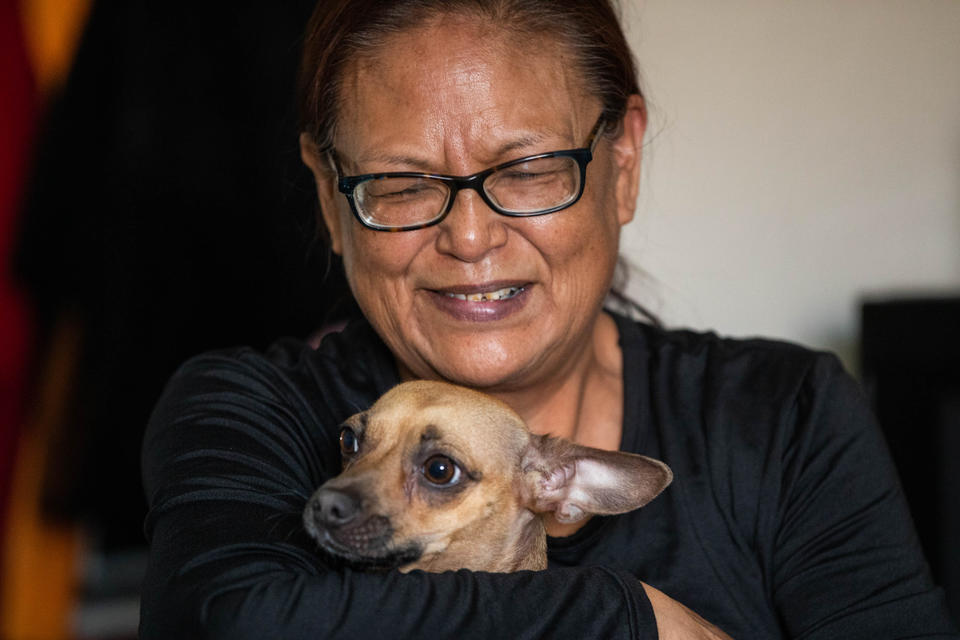
Jacqueline Gabriel, 59, holds her dog, Queenie, in her room at Neighborhood Apartments, a permanent supportive housing unit, on June 1, 2023. Gabriel moved in at the end of March of this year. This place of her own meant she no longer needed to spend her time and energy figuring out where she would sleep. (Amanda Snyder/Crosscut)
For Gabriel, having her own place means she no longer has to spend her time and energy, as she had for a decade, figuring out where she and her children will sleep.
Gabriel now has a primary care provider and regular medical appointments. A few weeks ago, she got bloodwork to diagnose some of her ongoing health issues. Daily, she completes a morning routine that includes prayer, a cup of coffee and breakfast. She thinks of things she wants to do to improve her physical and mental health, such as taking a yoga class.
“I want to remain strong for my family,” she said. “I plan to take better care of myself.”
More chronic homelessness
For most of the past 13 years, the number of Yakima County individuals experiencing homelessness has been between 600 and 700, according to the county’s annual Point in Time Count. In the 2022 Count, which counts people living on the street, in tents, in their vehicles and in temporary shelters, 670 individuals — and 554 households — said they were homeless.
However, most consider the Point in Time Count a massive undercount of a community’s homeless population, given that some don’t consent to participate and others are out of sight or couch-surfing during the Count.
In recent years, the state Department of Commerce, which oversees several housing and homelessness programs, has started compiling additional data to get a better idea of how many Washingtonians are experiencing homelessness.
The state’s Snapshot of Homelessness is based on housing information from those who receive Medicaid, food assistance or housing assistance, Not surprisingly, this data shows a far greater number of Yakima County people unhoused.
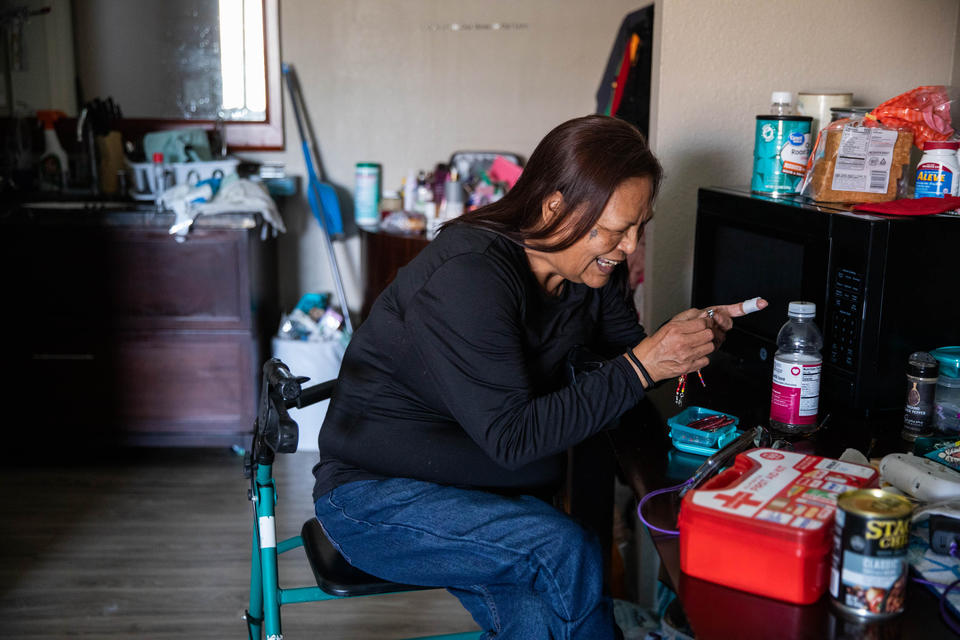
Jacqueline Gabriel, 59, goes through her beadwork in her apartment at Neighborhood Apartments. Gabriel has dealt with a decade of homelessness and housing instability and recently moved into the supportive housing unit in March. Instead of worrying about housing, she’s looking forward to attending powwows and working on her beadwork. (Amanda Snyder/Crosscut)
As of January, nearly 9,500 Yakima County residents were classified as homeless, a 15% increase from a year earlier and more than 10 times the Point in Time Count. Add people who are experiencing housing instability and at risk of becoming homeless, and that number increases to more than 11,000.
Still, Magasis said the Point in Time data helps identify trends — for instance, the high percentage of chronic homelessness in Yakima County, particularly among those living on the streets.
Nearly a third of Yakima County’s 554 homeless households counted in 2022 were unsheltered – living outside, in vehicles or in abandoned buildings. And 73% of those unsheltered households were identified as chronically homeless.
Among those unsheltered are those who live in encampments in the Yakima Greenway, a 20-mile pathway along the banks of Naches and Yakima rivers. The Yakima County Board of County Commissioners has drafted plans to remove these encampments.
Commissioners say the encampments are unsafe to live in and cause environmental damage. However, the proposal has generated concern from both law enforcement, concerned they do not have the staff to enforce new regulations, and homeless advocates who question whether there are other ways to address the issue, according to a recent report from the Yakima Herald-Republic.
Magasis notes there is also anecdotal evidence that a larger percentage of homeless residents in the county are dealing with substance-abuse or mental health issues. Indeed, the Point in Time survey also lists substance addiction and mental health as the top causes of homelessness in Yakima County.
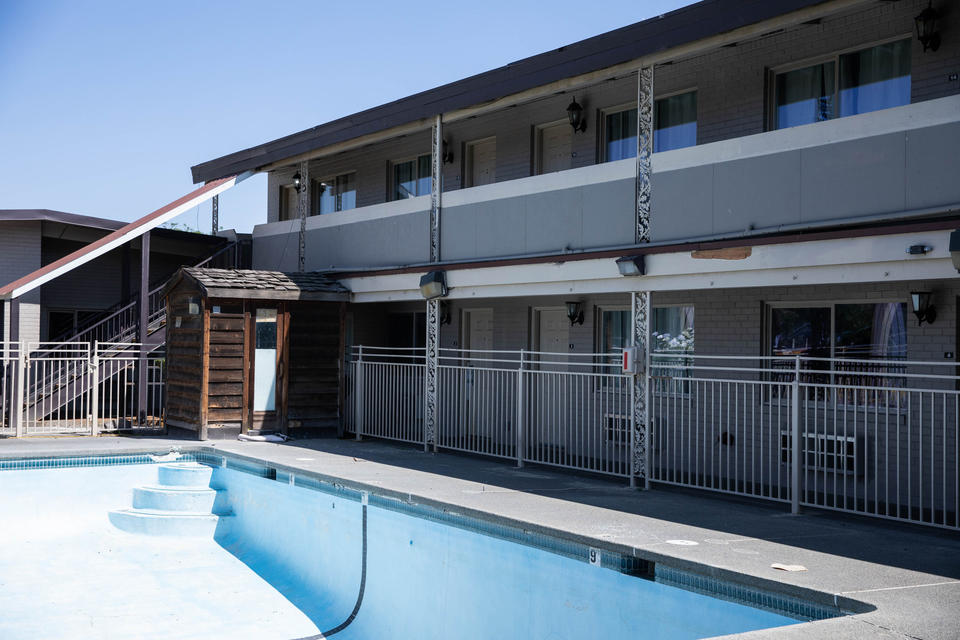
Neighborhood Apartments, a permanent supportive housing unit, is a former Yakima motel, seen on June 1, 2023. (Amanda Snyder/Crosscut)
For Rhonda Hauff, CEO of Yakima Neighborhood Health Services, the data aligns with the experiences of that organization’s outreach workers, including with Neighborhood Showers, their mobile showers unit parked in various spots around town.
“One of the things I used to say, ‘We knew everyone [who was] unsheltered by name,’” Hauff said. “And now we don’t. Because of our new hygiene unit, we’re meeting people who are unsheltered [who] we don’t know.”
by Grace Palmieri
The inception of ‘Housing First’
While the “Housing First” model, and the use of permanent supportive housing, has gained local and statewide interest as a way to address homelessness, this model has been developed over several decades.
Among the early adopters was the Downtown Emergency Service Center, or DESC, in downtown Seattle. The nonprofit, founded in 1979, started by running large congregate shelters aimed at populations with higher needs, including those dealing with substance-abuse disorders and mental health issues.
“We knew from experience that getting housing for our clients was very difficult,” said Daniel Malone, DESC’s executive director. “Even subsidized housing was not obtainable.”
The organization decided to start building its own housing for those residents in the early 1990s, and opened its first permanent supportive housing development in the Pioneer Square neighborhood in 1994.
Malone and the rest of the organization learned quickly that it was unintentionally putting barriers before the very people it wanted to serve by seeking those “ready for housing” or those who showed interest in services.
So for one housing development, DESC decided to offer housing to those dealing with severe addiction or mental health issues with no requirement to seek services or treatment before moving in.
“We figured the housing can be sort of a key tool in our ability to engage with people and actually get them to participate in more care and treatment with us,” Malone said.
And since it opened that apartment building and had that light-bulb moment, DESC has been a major player in supplying permanent supportive housing. The nonprofit has served as a model for organizations throughout the state and even the U.S. In 2007, DESC was featured in a study from the U.S. Department of Housing and Urban Development on models to provide housing for those dealing with mental health issues.
In Yakima County, Yakima Neighborhood Health Services was one of the early providers of permanent supportive housing. The federally qualified health care center began providing health care services for Yakima County’s homeless population in 2005.
But after a few years, Neighborhood Health realized securing housing was a key part of improving health care for those residents. At first the nonprofit offered a variety of housing options, but it now focuses on permanent supportive housing.
Today, the center has placed individuals and families in more than 150 housing units – some owned by the organization like the Neighborhood Apartments, and others it leases from private landlords.
More organizations getting involved
With the need for more housing, particularly for those experiencing chronic homelessness in Yakima County, more organizations are establishing permanent supportive housing, whether through new construction or by renovating existing hotels or housing units.

Michael Shay is seen by a dentist for a tooth extraction at the on-site clinic at Chuck Austin Place, a supportive housing development that targets formerly homeless veterans ,on June 1, 2023, in Yakima. (Amanda Snyder/Crosscut)
Marty Miller, executive director of the Office of Rural and Farmworker Housing, a nonprofit that works with service providers to develop housing, has witnessed this growing interest.
“We have seen in the last five-10 years a real uptick in homelessness in rural counties,” Miller said. “So now a lot of rural housing providers are trying to figure out how to meet that need.”
Among those Miller has worked with recently is Justice Housing Yakima, a nonprofit formed in 2016. David Helseth, a former pastor of Englewood Christian Church in Yakima who is now the group’s executive director, first got involved with serving those experiencing homelessness when the church agreed to house an emergency winter shelter in the early 2010s.
As he talked to those staying temporarily in the church, Helseth wondered what else could be done: “I realized, ‘This is not the end.’”
That started his research on what worked in other communities. Helseth started working with other advocates and explored tiny home developments throughout the Pacific Northwest, including Square One Villages in Eugene, Oregon, and Quixote Village in Olympia.
Together this group formed Justice Housing Yakima. The group first considered building a tiny home village, but eventually settled on a development called Cottage Hill Place, which features several rows of four to five attached cottage-style homes. Residents would still have their own homes, but the setup is designed to foster community among residents and create a sense of security and safety, Helseth said.
They hope to start construction in the coming months and begin housing people sometime in 2024.
Meanwhile, Catholic Charities Housing Services is working on another development that would bring additional permanent supportive housing units to Yakima. The nonprofit has built several apartment buildings and single-family homes in low-income residents in nearly 20 communities around Central Washington, including housing for seniors and farm workers.
But the organization’s staff and board members have been talking about pivoting to address homelessness in Wenatchee, Yakima and other Central Washington communities. Since they have experience building apartments and houses, developing permanent supportive housing seemed like a better fit than operating an emergency shelter, said Bryan Ketcham, director of Catholic Charities Housing Services.
After looking at different models across the Pacific Northwest, including Neighborhood Health in Yakima and at DESC in Seattle, the nonprofit started renting its first permanent supportive housing units from a new apartment complex in Wenatchee in 2020, with a focus on homeless families.
Over the past decade, Wenatchee and the rest of Chelan County, in north Central Washington, has seen homes become less and less affordable and vacancies drop to nearly zero. In recent years the county has reported some of the most expensive home prices in Eastern Washington, comparable to some counties in Western Washington.
Ketcham remembers visiting one shelter and seeing a rack full of kids’ bikes — illustrating the need for more family housing, not just for individuals who could not afford market-rate housing.
Now Catholic Charities is looking to replicate that model in Yakima with a new development. And like the building in Wenatchee, it would house a mix of people, including residents with disabilities, families and young adults, including those over 18 exiting foster care. Catholic Charities had been running a program in Yakima for homeless youth aged 15 to 24, including finding them housing. Providing housing and working with the existing case managers from that program made sense.
Getting the money
Catholic Charities has purchased a parcel in east Yakima, but that project cannot move forward until they have the money to build. The organization was turned down for a grant from the state Housing Trust Fund. Without that grant, the nonprofit is finding it difficult to secure the rest of the money it needs for the development, Ketcham said.
“If you’re missing one piece of the funding puzzle, it all collapses,” Ketcham said. “So we’re retooling. Now, we’ll plan on resubmitting [for state money] again this fall. And hopefully, we’ll be successful.”
Catholic Charities Housing Services’ ongoing challenge speaks to one of the biggest obstacles to increasing permanent supportive housing units in Yakima County and across the state: the upfront financial investment.
A provider of housing often has to seek multiple funding sources not only for construction but for operational costs, including basic costs like water, sewer and electricity, plus case management and other services the residents would receive.
Miller of the Office of Rural and Farmworker Housing offered a rough estimate of $200,000 to $300,000 per unit, but with construction costs continuing to increase, the building costs could easily be higher.
Since permanent supportive housing residents are extremely low-income – generally 0% to 30% of area median income – it’s difficult to secure traditional financing, because banks base their lending on how much income, i.e., rent, the housing development receives, and that amount usually is short of the building cost.
That means developers must seek state or federal dollars, such as the Housing Trust Fund from the Washington Department of Commerce.
Several Yakima area developments, including Neighborhood Apartments and Cottage Hill Place in Yakima, have been able to purchase property or pay for construction costs through Housing Trust Fund grants. Developments in Yakima County received nearly $13 million toward creating 99 units of permanent supportive housing in the current biennium, according to Department of Commerce figures.
Ryan Blackledge and his family are among the people benefitting from those investments in Yakima. Blackledge had lived with his parents off and on since he graduated from high school in the late 2000s. Eventually that unstable housing situation included a family – his wife Alex and four daughters ranging in age from 8 months to 11 years.
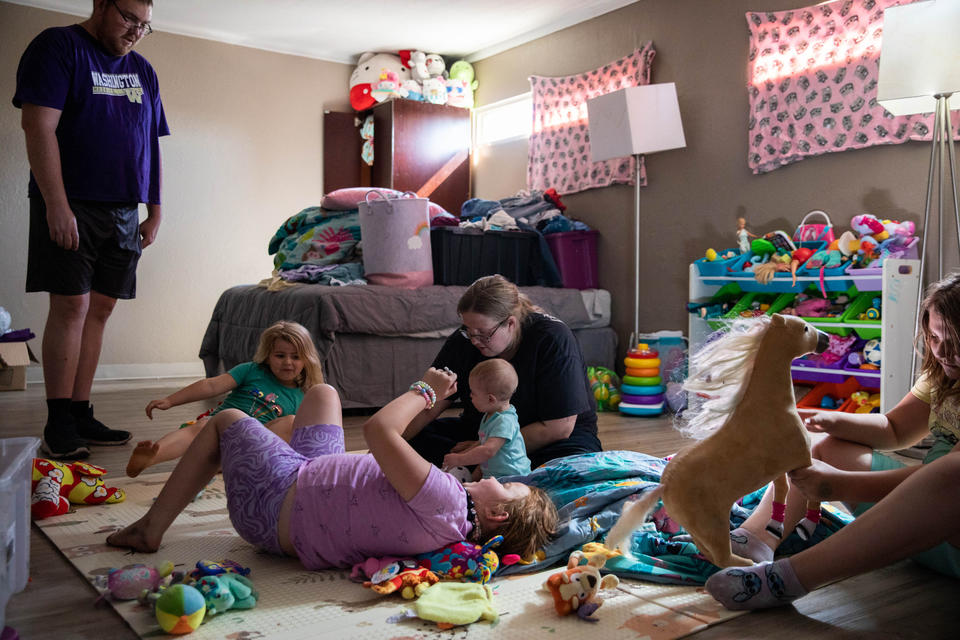
The Blackedge family hangs out in the girls’ room at Neighborhood Apartments. Blackedge and his family tried to live on their own in the Tri-Cities twice but could never secure a rental as the family’s primary income was from doing deliveries via an online app. Those jobs couldn’t provide the verification needed by landlords and rental agencies to secure a place. (Amanda Snyder/Crosscut)
Blackledge and his family attempted to live on their own in the Tri-Cities twice but couldn’t afford to rent because the family’s primary income came from making deliveries via an online app, which couldn’t provide the verification needed by landlords and rental agencies. As a result, Blackledge spent thousands of dollars a month on hotel rooms and then returned to his parents’ home.
He’s grateful for his parents’ generosity – and they never threatened to kick the family out – but it became clear that having seven people in that space was taking its toll. Blackledge’s wife was pregnant with their fourth child. Tensions were high between Blackledge and his father. Blackledge’s depression ramped up, and he had suicidal thoughts.
They ended up at the Union Gospel Mission family shelter in December. But they weren’t there for long: In April, he and his family moved into the Neighborhood Apartments in Yakima.
“I needed space to address my issues,” he said. “I needed to be out on my own.”
Blackledge said he’s regularly been able to see a therapist “he loves.” He’s also grateful that he and his family have a place. And he’s also been able to savor moments such as seeing one of his daughters make a new friend at school.
They’re thinking about the future now. “My dream is to buy my own home,” he said, “Or at least move to a bigger place.”
Since 1986, the Housing Trust Fund has put more than $1 billion in state tax dollars into building or preserving more than 50,000 affordable housing units statewide, according to the Department of Commerce. The capital budget for the next biennium includes a boost in state dollars for the fund.
While nonprofits do most of the leg work to address homelessness in Washington, much of the money to pay for this work comes from state tax dollars. But that money is not unlimited, so demand still outstrips supply, and some organizations have to go through the funding application process several times before getting state dollars to build.
Providers are pushing the city of Yakima or Yakima County to pass a sales tax increase of one tenth of 1% for affordable-housing programs.
While the tax would generate only a few million dollars a year, a housing provider or nonprofit can use that money as leverage when applying for state or federal funds, Miller said. Communities that have adopted the optional sales tax increase have also been successful in securing state dollars for their construction projects.
The Yakima City Council had a 4-2 vote for the tax in 2021, just short of the supermajority required to adopt the tax. Yakima County has yet to consider the tax increase.
“That hampers our efforts a lot,” Miller said. “Other communities are able to provide local leverage to go after state funds. We’ve elected not to do that.”
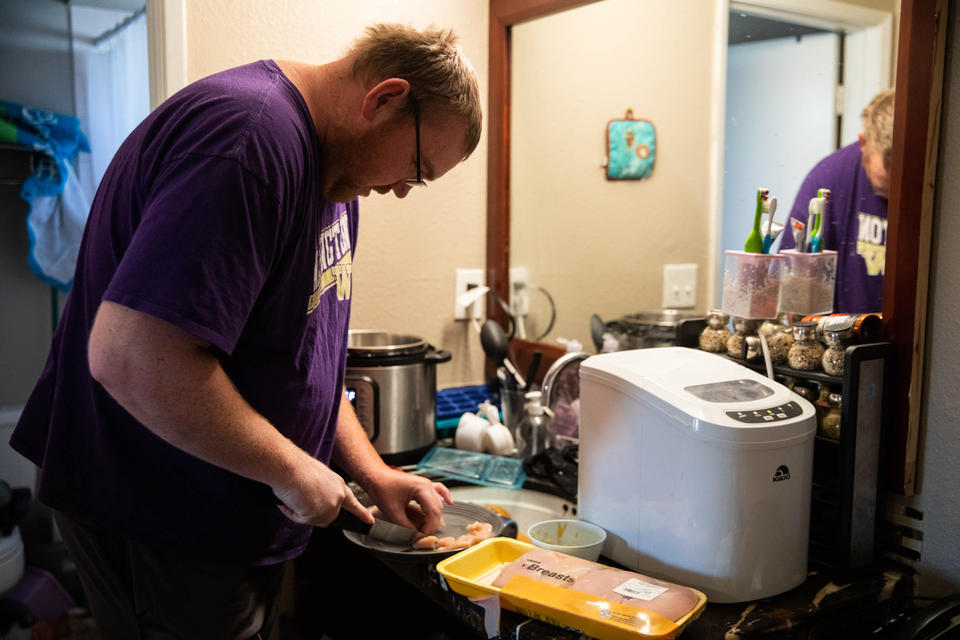
Ryan Blackedge cuts chicken at the bathroom sink for their family dinner in their apartment. Blackedge is grateful for his family to have their own place. One of his and his wife’s priorities is getting his girls used to having their own place.(Amanda Snyder/Crosscut)
Yakima City Councilwoman Soneya Lund, who voted for the tax, believes it would be difficult to take another sales tax vote at the City Council, but thinks it could pass as an initiative on the local ballot if local citizens are educated on the impact of the tax.
She’s seen that happen in Vancouver, where “They’ve been building affordable housing of all kinds,” she said.
Still, homeless advocates and nonprofits seeking to develop permanent supportive housing say city and county officials have shown support in other ways.
Helseth, the Justice Housing Yakima director, notes that the city of Yakima secured thousands of dollars in grants that will cover the cost of hooking up water and sewer lines for the Cottage Hill Place development. The city also adjusted regulations, such as lowering the number of required parking spots. “They’re trying to eliminate barriers where they can,” he said.
Likewise, city and county staff and officials said they are willing to pursue different avenues to help permanent supportive housing developments move forward.
Joan Davenport, community development director for the city of Yakima, said the city had spent the last several years looking at ways to streamline the housing development process, including for those building permanent supportive housing. She believes that homelessness is a housing issue and adding more housing is crucial to solving it.
Yakima County Commissioner Kyle Curtis said there are existing local funds generated by the county, such as a 0.1% sales tax designed for mental health services passed in 2019, or federal dollars that could help cover operation costs or be used as leverage for additional state dollars.
Curtis said he feels the county’s role is not to build the housing but to help providers and nonprofits use local dollars to secure additional money from state and federal sources to cover multimillion-dollar housing developments.
Regarding the possibility of passing a sales tax for affordable housing, Curtis said, “I do think 1/10 of 1% for affordable housing is a conversation the [Yakima County Commissioners] will need to have.”
On the operations side, while most permanent supportive housing has residents cover part of their rental costs up to 30% of their income, that amount falls well short of the amount needed to maintain the building and provide supportive services.
One possible game-changer for the Yakima Housing Authority is the organization’s new designation as a “Moving to Work” agency, which allows them more flexibility with their housing vouchers, enabling them to direct more project-based vouchers toward permanent supportive housing units, said Lowel Krueger, the Yakima Housing Authority’s executive director.
Project-based vouchers are tied to the housing unit rather than the tenant. The Yakima Housing Authority used its own project-based vouchers to help pay for Chuck Austin Place, a permanent supportive housing development focused on housing veterans.
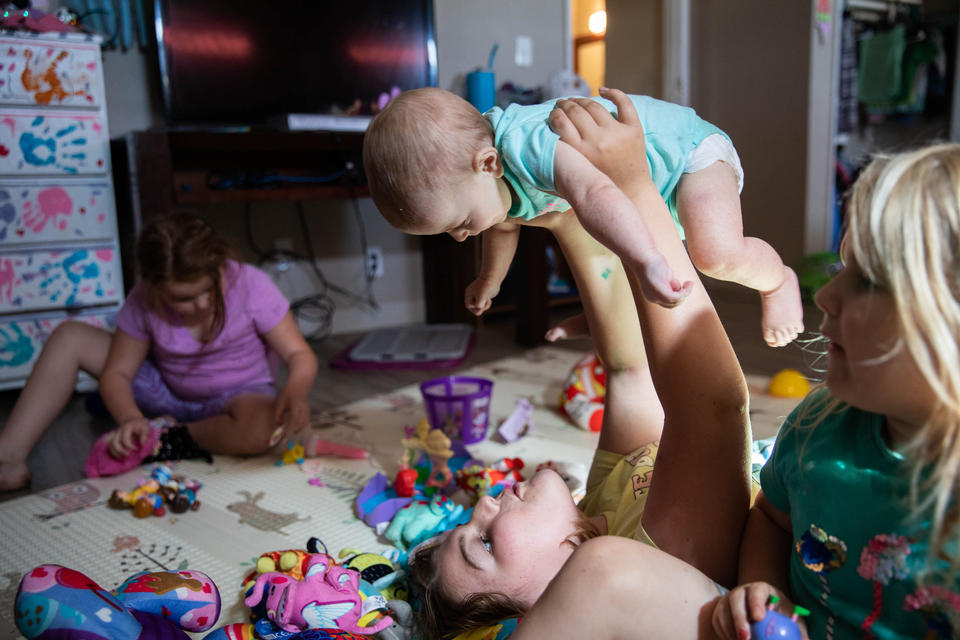
Aimee Blackedge, 11, holds up her sister Roselynn as they play with toys in their room at Neighborhood Apartments. (Amanda Snyder/Crosscut)
Those vouchers will be a crucial stream of money for Justice Housing Yakima’s Cottage Hill Place, Helseth said. That organization also hopes to secure state housing maintenance funds, which can be annually renewed.
The state’s Apple Health and Homes program has connected multiple agencies, including Commerce and the Health Care Authority, to use Medicaid dollars and additional housing money to provide money to build permanent supportive housing in Yakima and statewide
While generally, Medicaid can’t be used for housing, it can be used for supportive services associated with housing. And some states have found ways to get approval to use these federal dollars for rental assistance, said Melodie Pazolt, managing director of the Office of Apple Health and Homes and permanent supportive housing for Commerce.
This problem can be solved
While challenges remain — and some may disagree on the solutions — there is a general sense of optimism in the Yakima Valley that the region’s homelessness is still a manageable issue that can be addressed if not eliminated.
Hauff, the Neighborhood Health CEO, doesn’t think the goal of eliminating homelessness is realistic considering the region’s poverty, but she does believe the region could see more people exiting homelessness than those who are moving toward housing instability.
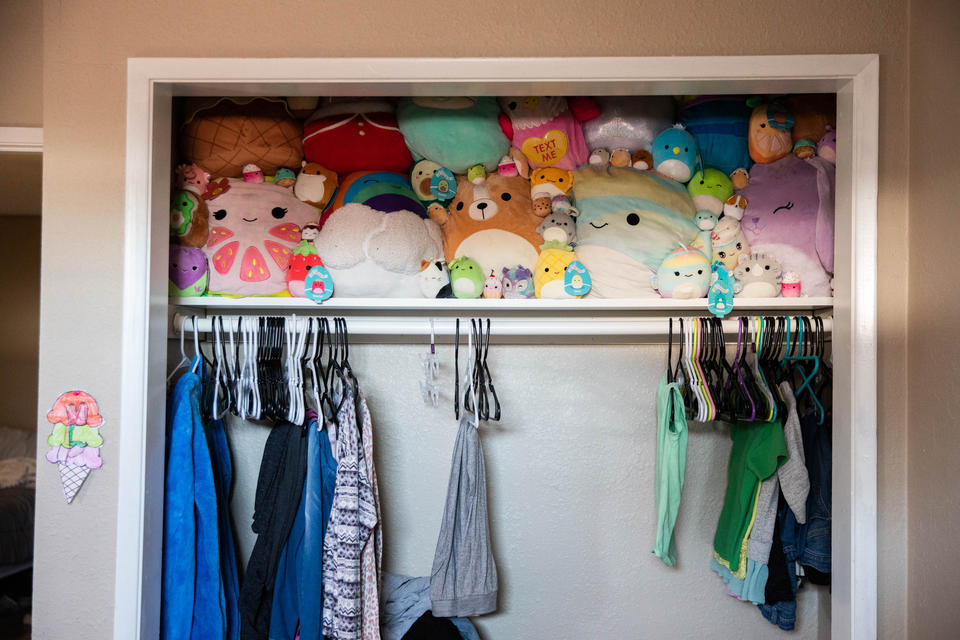
The girls’ closet is filled with Pusheen stuffed animals in their apartment. Each of the girls gets their own corner of the room to put their toys in. (Amanda Snyder/Crosscut)
Through early adopters like DESC and Neighborhood Health, research has shown that permanent supportive housing is a solution to chronic homelessness.
According to data from the state Department of Commerce, so far in the 2023 fiscal year 97% of those in permanent supportive housing in Yakima County have been able to retain that housing or move into other permanent housing. For all of the state’s 34 small and medium-sized counties — excluding King, Pierce, Snohomish, Spokane and Clark — it’s 99%.
The National Alliance to End Homelessness notes a number of studies that show similar positive outcomes. For example residents whose housing needs are met are better able to access necessary services and treatment. More important, this increases financial efficiency, as those in permanent housing no longer require other services such as short-term shelters or jails. The Alliance cited studies showing savings on other homeless emergency services of anywhere from $23,000 to $31,545 per person. And this goal also seems obtainable when Hauff sees the number of people her organization has helped through its permanent supportive housing program.
Indeed, at the Neighborhood Apartments, new residents have been able to look forward to the future now that they don’t have to worry about a place to sleep.
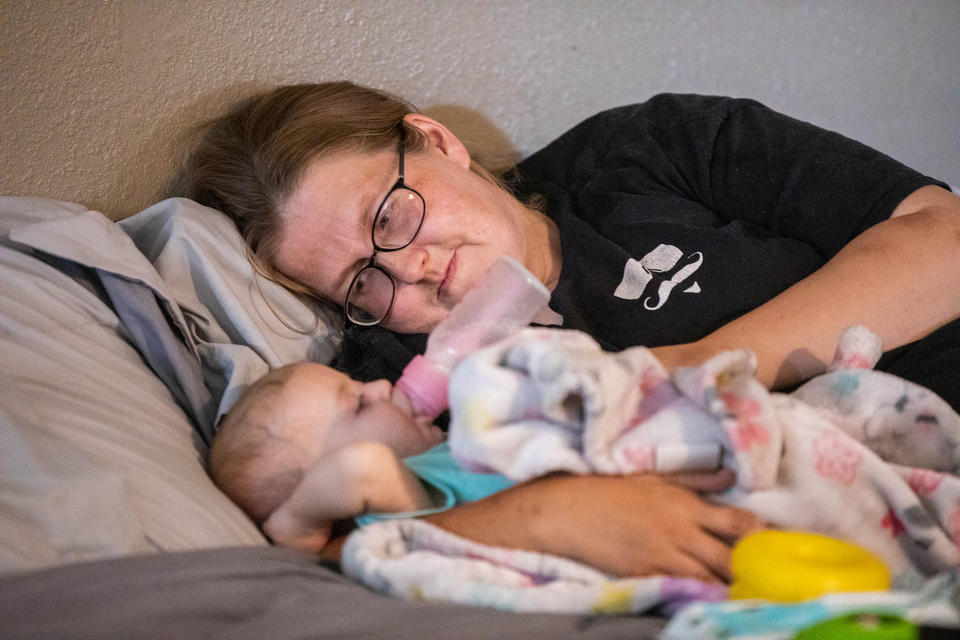
Alex Blackedge feeds Roselynn a bottle in their apartment. (Amanda Snyder/Crosscut)
Gabriel, who has experienced a decade of homelessness and housing instability, won’t be thinking about how to survive triple-digit temperatures this summer. Instead, she’s looking forward to attending powwows in the Pacific Northwest, working on her beadwork and perhaps running a stand to sell fry bread, a popular Native food.
The little moments matter: One of Gabriel’s favorite things each day is walking her dog Queenie and stopping to smell the roses in front of the Neighborhood Apartments.
Given the trauma she’s endured during prolonged homelessness, she’s shy and reserved and hasn’t gotten to know the neighbors yet. She said she was anxious during those first weeks when her case manager knocked on her door.
“You lose family members, you lose friends [when homeless], you feel alone,” she said.
Now she’s come to look forward to— and value — those frequent check-ins and conversations. And she knows her case manager can support her as she aspires to her goals and can be relied on when she needs help.
“It’s good to have someone who listens to you,” she said.
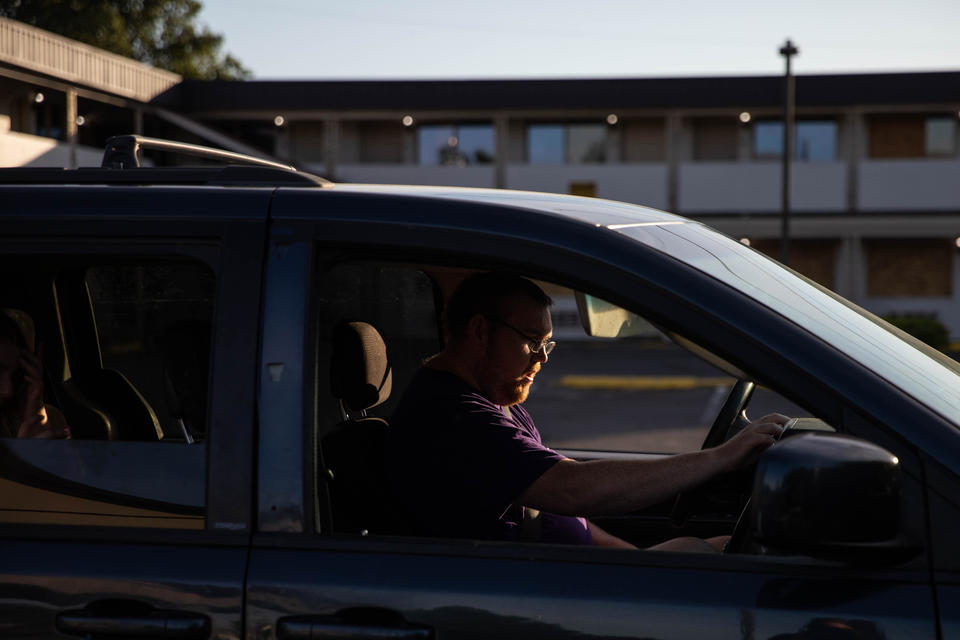
Ryan Blackedge starts the car to go pick up his sister in Yakima. (Amanda Snyder/Crosscut)
Visit crosscut.com/donate to support nonprofit, freely distributed, local journalism.
—
Previously Published on crosscut
***
You Might Also Like These From The Good Men Project
 Compliments Men Want to Hear More Often Compliments Men Want to Hear More Often |
 Relationships Aren’t Easy, But They’re Worth It Relationships Aren’t Easy, But They’re Worth It |
 The One Thing Men Want More Than Sex The One Thing Men Want More Than Sex |
 ..A Man’s Kiss Tells You Everything ..A Man’s Kiss Tells You Everything |
Join The Good Men Project as a Premium Member today.
All Premium Members get to view The Good Men Project with NO ADS. A $50 annual membership gives you an all access pass. You can be a part of every call, group, class and community. A $25 annual membership gives you access to one class, one Social Interest group and our online communities. A $12 annual membership gives you access to our Friday calls with the publisher, our online community.
Register New Account
Log in if you wish to renew an existing subscription.
Need more info? A complete list of benefits is here.
—
Photo credit: Ryan Blackledge and family eat dinner and hang out in their apartment at Neighborhood Apartments, a permanent supportive housing unit, on Tuesday, June 6, 2023. (Amanda Snyder/Crosscut)
The post Homelessness Efforts in Yakima Are Moving Toward Permanent Housing appeared first on The Good Men Project.
